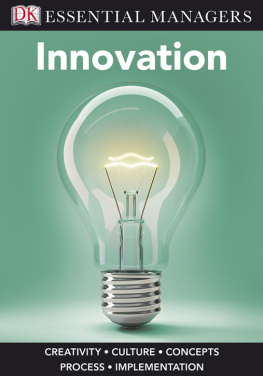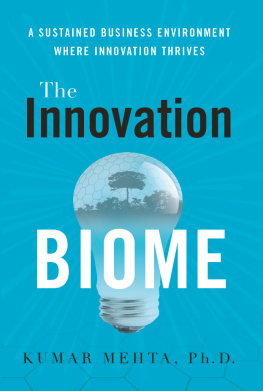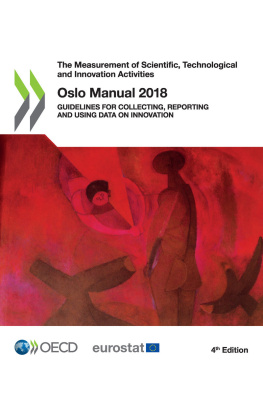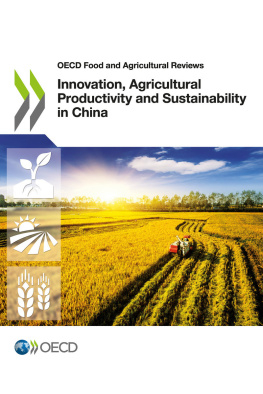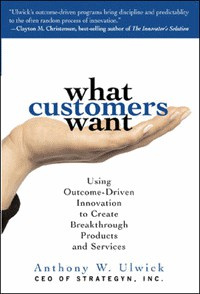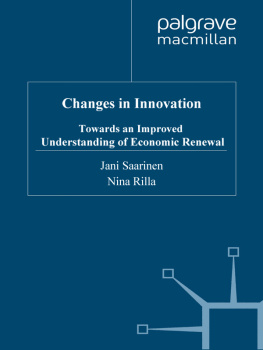BEYOND THE CHAMPION
Institutionalizing Innovation Through People
Gina Colarelli OConnor,
Andrew C. Corbett,
Lois S. Peters
STANFORD BUSINESS BOOKS
An Imprint of Stanford University Press
Stanford, California
Stanford, California
2018 by the Board of Trustees of the Leland Stanford Junior University. All rights reserved.
No part of this book may be reproduced or transmitted in any form or by any means, electronic or mechanical, including photocopying and recording, or in any information storage or retrieval system without the prior written permission of Stanford University Press.
Special discounts for bulk quantities of Stanford Business Books are available to corporations, professional associations, and other organizations. For details and discount information, contact the special sales department of Stanford University Press. Tel: (650) 725-0820, Fax: (650) 725-3457
Printed in the United States of America on acid-free, archival-quality paper
Library of Congress Cataloging-in-Publication Data
Names: OConnor, Gina Colarelli, author. | Corbett, Andrew C., author. | Peters, Lois S., author.
Title: Beyond the champion : institutionalizing innovation through people / Gina Colarelli OConnor, Andrew C. Corbett, Lois S. Peters.
Description: Stanford, California : Stanford Business Books, an imprint of Stanford University Press, 2018. | Includes bibliographical references and index.
Identifiers: LCCN 2017018407 (print) | LCCN 2017022303 (ebook) | ISBN 9781503604506 (e-book) | ISBN 9780804798273 (cloth : alk. paper) | ISBN 9781503604506 (ebook)
Subjects: LCSH: Technological innovationsManagement. | Organizational change.
Classification: LCC HD45 (ebook) | LCC HD45 .O258 2018 (print) | DDC 658.4/063dc23
LC record available at https://lccn.loc.gov/2017018407
Typeset by Newgen in Sabon 10 point.
As a research team, we dedicate this book to Bruce Kirk, director of innovation effectiveness at Corning, Inc., and Tracy Laverty, our PhD student. Both of these cherished people passed away during the time of our study, and both were influential contributors to it, in vastly different ways. We miss them terribly.
To my husband, Patrick, with love and gratitude.Gina OConnor
To my wife, Brenda: Im better at everything I do because of you. Your support, counsel, and love are foundational to who I am and everything I accomplish. Id also like to thank our two sons, Sean and Chase, two innovative minds. Keep following your entrepreneurial paths!Andrew Corbett
I dedicate this book and body of work to my husband and grandchildren. Garrett McCarey, my husband, is my friend and supporter, but most of all he keeps me laughing. My grandchildren, Erin, Olivia, Stephen, and Ryan, are innovators in their own right. I hope this book is an inspiration for them to keep developing their innovation talents to make an impact.Lois Peters
CONTENTS
ACKNOWLEDGMENTS
One day in 2010 Ted Farrington, research director at PepsiCo, called from out of the blue to ask when we were going to start the next phase of our research program on managing for breakthrough innovation in large, mature companies. We knew Ted because he had participated in the second phase of our research. This would be the third. Like the first two studies, it would be a significant undertaking. We gulped. We discussed it. Ted kept calling. The problems companies were facing in commercializing breakthroughs had certainly not been abated. Ultimately, we knew he was right.
Ted paved the way for us to return to the IRI, a wonderful, passionate organization of R&D leaders in large companies, whove sponsored our research since its inception in 1995. We already knew what the next research question of interest was, based on the most pressing challenges that surfaced in our second phase. We co-opted Bruce Kirk, our longtime supporter from Corning, to cochair with Ted the IRI subcommittee that would work with us throughout the project. It wasnt a difficult sell. Together we decided that our typical approach of ten to twelve companies was too much to handle, so wed try for six. Within three months we had eleven. And so it goes.
This research program, the entire three phases, would not be possible without the enduring support of the IRI. Its members confirm the importance of our research and let us know that it resonates with them. When our results dont make sense to them, they talk it through with us, and we come to new levels of understanding. When they dont like what we tell them, they stick with us and come away with new understandings themselves.
Some members of the IRI have been steady presences for a long time, and its the vibrancy of the organization that really helps us. Its structure includes a Research-on-Research committee, which oversees a portfolio of research projects on topics of interest to the R&D community, run by members. Ours has been one of those projects. With two cochairs (Bruce and Ted), and a show of hands indicating interest, we were off and running. ROR project committees meet three times per year. So thats how often we showed up to report on the projects status, develop and test surveys, provide interim results, and collect their feedback. The interesting thing is attendance at those meetings was fluid. Members from Bose, Masco, Dow Chemical, Rohm and Haas, Boeing, and a variety of other companies filtered through our committee over the years. It wasnt a stable group per se, and that meant we had many opportunities to get feedback, and many points of view to consider. Ted and Bruce were the stabilizing factor.
We must acknowledge the IRI, and its staff, who made this all possible. Ed Bernstein, president, was new to the organization when we began Phase I, and hes been inclusive, welcoming, and has done a great job of growing the organization, understanding its members needs, and working to augment the IRIs offerings. The industrial research community is in need of this vibrant professional organization, and in our view, he and his staff have stepped up. Lee Green, vice president of knowledge creation, oversees the Research-on-Research committee and provided unrelenting support. We know we can call her at any time. Martha Malone, vice president of education, and Jim Euchner, editor of Research-Technology Magazine, help us find ways to publicize and teach what weve learned as a result of this great partnership.
We must also acknowledge Ted Farrington, who has been such a strong supporter of our work, and is really a student of innovation leadership himself. Hes been an R&D director in a number of companies since we first encountered him at the IRI meetings, and has lent his perspective and his companies participation in several of our studies. Thank you, thank you, thank you, Ted.
We cannot acknowledge Ted without acknowledging Bruce Kirk, who, sadly, passed away suddenly just after completion of our data collection, and just after he retired. Bruce was a keen observer, an excellent meeting facilitator, and a great advocate. His passion for driving innovation excellence serves as a role model to many.
Finally, we express our gratitude to our participating companies for this particular study. Many provided financial support, and they all opened their doors and allowed us in. The topic of this book can become personal, and its not easy to share some of these difficult stories. Our company contacts identified people to us whod experienced difficult career options; and those people gave us the good, the bad, and the ugly. They did not try to present a sugarcoated story line. Others gave us real-world examples of solutions they were trying to implement, or success stories that had occurred in the company, and made introductions so that we could follow up. The degree of openness we experienced has allowed us to gain the insights described in this book and offer them up for corporate leaders and innovators to improve management practices associated with innovation talent.
Next page

